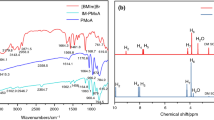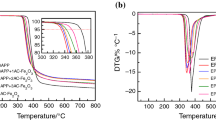Abstract
A new multifunctional ionic liquid-based metal–organic hybrid (PMAIL) was synthesized by anion exchange between as-synthesized phosphonate-based ionic liquid and phosphomolybdic acid and applied to epoxy resin (EP) as an efficient flame retardant. As expected, with only 1 wt% addition of PMAIL, the char yield of EP-PMAIL1 composite at 700 °C was significantly improved by 108.3% from 12.0% for neat epoxy resin to 25.0%, demonstrating the outstanding catalytic charring effect of PMAIL. Meanwhile, EP-PMAIL6 composite (6 wt% addition) can reach V-0 rating in the UL-94 vertical burning tests easily, and its peak heat release rate and total smoke production of EP-PMAIL6 were dropped by 31.0 and 15.4%, respectively, compared with neat EP. Moreover, the results from cone calorimetry tests showed that the char yield of EP-PMAIL6 was enhanced by 162% from 9.5 to 24.9% compared with neat EP, resulting in a strong intumescent char layer structure with outstanding fire retardance and mechanical properties. The thermo-oxidative stable protective layer retarded the transfer of heat and flammable volatiles during combustion and protected the epoxy matrix from further degradation. In conclusion, our results might provide a new perspective for producing composites with excellent flame retardancy and smoke suppression properties using ionic liquid-based metal–organic hybrid.








Similar content being viewed by others
References
Wicklein B, Kocjan A, Salazar-Alvarez G, Carosio F, Camino G, Antonietti M, Bergstrom L (2015) Thermally insulating and fire-retardant lightweight anisotropic foams based on nanocellulose and graphene oxide. Nat Nanotechnol 10(3):277–283
Bar M, Alagirusamy R, Das A (2015) Flame retardant polymer composites. Fiber Polym 16(4):705–717
Higginbotham AL, Lomeda JR, Morgan AB, Tour JM (2009) Graphite oxide flame-retardant polymer nanocomposites. ACS Appl Mater Interfaces 1(10):2256–2261
Gu H, Ma C, Gu J, Guo J, Yan X, Huang J, Zhang Q, Guo Z (2016) An overview of multifunctional epoxy nanocomposites. J Mater Chem C 4(25):5890–5906
Jin F, Li X, Park S (2015) Synthesis and application of epoxy resins: a review. J Ind Eng Chem 29:1–11
Tan Y, Shao Z, Yu L, Long J, Qi M, Chen L, Wang Y (2016) Piperazine-modified ammonium polyphosphate as monocomponent flame-retardant hardener for epoxy resin: flame retardance, curing behavior and mechanical property. Polym Chem 7(17):3003–3012
Müller P, Morys M, Sut A, Jäger C, Illerhaus B, Schartel B (2016) Melamine poly(zinc phosphate) as flame retardant in epoxy resin: decomposition pathways, molecular mechanisms and morphology of fire residues. Polym Degrad Stab 130:307–319
Shi Y, Wang G (2016) The novel epoxy/PEPA phosphate flame retardants: synthesis, characterization and application in transparent intumescent fire resistant coatings. Prog Org Coat 97:1–9
Shao ZB, Deng C, Tan Y, Chen MJ, Chen L, Wang YZ (2014) An efficient mono-component polymeric intumescent flame retardant for polypropylene: preparation and application. ACS Appl Mater Interfaces 6(10):7363–7370
Xu M-J, Xu G-R, Leng Y, Li B (2016) Synthesis of a novel flame retardant based on cyclotriphosphazene and DOPO groups and its application in epoxy resins. Polym Degrad Stab 123:105–114
Yang S, Zhang Q, Hu Y (2016) Synthesis of a novel flame retardant containing phosphorus, nitrogen and boron and its application in flame-retardant epoxy resin. Polym Degrad Stab 133:358–366
Liu C, Chen T, Yuan CH, Song CF, Chang Y, Chen GR, Xu YT, Dai LZ (2016) Modification of epoxy resin through the self-assembly of a surfactant-like multi-element flame retardant. J Mater Chem A 4(9):3462–3470
Zhang W, Fina A, Cuttica F, Camino G, Yang R (2016) Blowing-out effect in flame retarding epoxy resins: insight by temperature measurements during forced combustion. Polym Degrad Stab 131:82–90
Zhang W, Camino G, Yang R (2017) Polymer/polyhedral oligomeric silsesquioxane (POSS) nanocomposites: an overview of fire retardance. Prog Polym Sci 67:77–125
Kalali EN, Wang X, Wang D-Y (2016) Multifunctional intercalation in layered double hydroxide: toward multifunctional nanohybrids for epoxy resin. J Mater Chem A 4(6):2147–2157
Liu S, Yan H, Fang Z, Guo Z, Wang H (2014) Effect of graphene nanosheets and layered double hydroxides on the flame retardancy and thermal degradation of epoxy resin. RSC Adv 4(36):18652–18659
Gao Y, Wu J, Wang Q, Wilkie CA, O’Hare D (2014) Flame retardant polymer/layered double hydroxide nanocomposites. J Mater Chem A 2(29):10996–11016
Jiang S-D, Bai Z-M, Tang G, Song L, Stec AA, Hull TR, Zhan J, Hu Y (2014) Fabrication of Ce-doped MnO2 decorated graphene sheets for fire safety applications of epoxy composites: flame retardancy, smoke suppression and mechanism. J Mater Chem A 2(41):17341–17351
MacFarlane DR, Tachikawa N, Forsyth M, Pringle JM, Howlett PC, Elliott GD, Davis JH, Watanabe M, Simon P, Angell CA (2014) Energy applications of ionic liquids. Energy Environ Sci 7(1):232–250
Steinrueck HP, Wasserscheid P (2015) Ionic liquids in catalysis. Catal Lett 145(1):380–397
Smiglak M, Pringle J, Lu X, Han L, Zhang S, Gao H, MacFarlane D, Rogers R (2014) Ionic liquids for energy, materials, and medicine. Chem Commun 50(66):9228–9250
Sonnier R, Dumazert L, Livi S, Nguyen TKL, Duchet-Rumeau J, Vahabi H, Laheurte P (2016) Flame retardancy of phosphorus-containing ionic liquid based epoxy networks. Polym Degrad Stab 134:186–193
Gui H, Xu P, Hu Y, Wang J, Yang X, Bahader A, Ding Y (2015) Synergistic effect of graphene and an ionic liquid containing phosphonium on the thermal stability and flame retardancy of polylactide. RSC Adv 5(35):27814–27822
Chen S, Li J, Zhu Y, Guo Z, Su S (2013) Increasing the efficiency of intumescent flame retardant polypropylene catalyzed by polyoxometalate based ionic liquid. J Mater Chem A 1(48):15242–15246
Ye T, Li J (2016) Effect of anion of polyoxometalate based organic–inorganic hybrid material on intumescent flame retardant polypropylene. Polym Adv Technol 27(9):1211–1219
Hu Y, Xu P, Gui H, Wang X, Ding Y (2015) Effect of imidazolium phosphate and multiwalled carbon nanotubes on thermal stability and flame retardancy of polylactide. Compos Part A Appl Sci 77:147–153
Kuo P, Tsao C, Hsu C, Chen S, Hsu H (2016) A new strategy for preparing oligomeric ionic liquid gel polymer electrolytes for high-performance and nonflammable lithium ion batteries. J Membr Sci 499:462–469
Xiao F, Wu K, Luo F, Guo Y, Zhang S, Du X, Zhu Q, Lu M (2017) An efficient phosphonate-based ionic liquid on flame retardancy and mechanical property of epoxy resin. J Mater Sci 52(24):13992–14003
Liu M, Zhang X, Zammarano M, Gilman JW, Kashiwagi T (2011) Flame retardancy of poly (styrene-co-acrylonitrile) by the synergistic interaction between clay and phosphomolybdate hydrates. Polym Degrad Stab 96(5):1000–1008
Mel’nik OA, Shaplov AS, Lozinskaya EI, Popova NA, Makarov MV, Odinets IL, Lysenko KA, Timofeeva GI, Malyshkina IA, Vygodskii YS (2010) Polymers based on ionic monomers with side phosphonate groups. Polym Sci Ser B 52(5–6):316–326
Wang X, Zhou S, Guo W, Wang P, Xing W, Song L, Hu Y (2017) Renewable cardanol-based phosphate as a flame retardant toughening agent for epoxy resins. ACS Sustain Chem Eng 5(4):3409–3416
Fernandes DM, Barbosa AD, Pires J, Balula SS, Cunha-Silva L, Freire C (2013) Novel composite material polyoxovanadate@ MIL-101(Cr): a highly efficient electrocatalyst for ascorbic acid oxidation. ACS Appl Mater Interfaces 5(24):13382–13390
Shaplov AS, Goujon L, Vidal F, Lozinskaya EI, Meyer F, Malyshkina IA, Chevrot C, Teyssié D, Odinets IL, Vygodskii YS (2009) Ionic IPNs as novel candidates for highly conductive solid polymer electrolytes. J Polym Sci Polym Chem 47(17):4245–4266
Chen S, Li J, Zhu Y, Su S (2014) Roles of anion of polyoxometalate-based ionic liquids in properties of intumescent flame retardant polypropylene. RSC Adv 4(62):32902–32913
Wang S, Ma S, Xu C, Liu Y, Dai J, Wang Z, Liu X, Chen J, Shen X, Wei J, Zhu J (2017) Vanillin-derived high-performance flame retardant epoxy resins: facile synthesis and properties. Macromolecules 50(5):1892–1901
Wang X, Hu Y, Song L, Xing WY, Lu HDA, Lv P, Jie GX (2010) Flame retardancy and thermal degradation mechanism of epoxy resin composites based on a DOPO substituted organophosphorus oligomer. Polymer 51(11):2435–2445
Alongi J, Han Z, Bourbigot S (2015) Intumescence: tradition versus novelty. A comprehensive review. Prog Polym Sci 51:28–73
Jin X, Sun J, Zhang JS, Gu X, Bourbigot S, Li H, Tang W, Zhang S (2017) The preparation of a novel intumescent flame retardant based on supramolecular interactions and its application in polyamide 11. ACS Appl Mater Interfaces 9:24964–24975
Qiu S, Ma C, Wang X, Zhou X, Feng X, Yuen RKK, Hu Y (2018) Melamine-containing polyphosphazene wrapped ammonium polyphosphate: a novel multifunctional organic–inorganic hybrid flame retardant. J Hazard Mater 344:839–848
Zhao X, Xiao D, Alonso JP, Wang D-Y (2017) Inclusion complex between beta-cyclodextrin and phenylphosphonicdiamide as novel bio-based flame retardant to epoxy: inclusion behavior, characterization and flammability. Mater Des 114:623–632
Qian X, Song L, Hu Y, Yuen RKK (2013) Thermal degradation and flammability of novel organic/inorganic epoxy hybrids containing organophosphorus-modified oligosiloxane. Thermochim Acta 552:87–97
Luo F, Wu K, Lu M (2016) Enhanced thermal stability and flame retardancy of polyurethane foam composites with polybenzoxazine modified ammonium polyphosphates. RSC Adv 6(16):13418–13425
Shen D, Xu YJ, Long JW, Shi XH, Chen L, Wang YZ (2017) Epoxy resin flame-retarded via a novel melamine-organophosphinic acid salt: thermal stability, flame retardance and pyrolysis behavior. J Anal Appl Pyrol 128:54–63
Chen C, Gu X, Jin X, Sun J, Zhang S (2017) The effect of chitosan on the flammability and thermal stability of polylactic acid/ammonium polyphosphate biocomposites. Carbohydr Polym 157:1586–1593
Sun J, Gu X, Zhang S, Coquelle M, Bourbigot S, Duquesne S, Casetta M (2014) Improving the flame retardancy of polyamide 6 by incorporating hexachlorocyclotriphosphazene modified MWNT. Polym Adv Technol 25(10):1099–1107
Tan Y, Shao ZB, Chen XF, Long JW, Chen L, Wang YZ (2015) Novel multifunctional organic–inorganic hybrid curing agent with high flame-retardant efficiency for epoxy resin. ACS Appl Mater Interfaces 7(32):17919–17928
Chen X, Jiang Y, Jiao C (2014) Smoke suppression properties of ferrite yellow on flame retardant thermoplastic polyurethane based on ammonium polyphosphate. J Hazard Mater 266:114–121
Wan J, Gan B, Li C, Molina-Aldareguia J, Li Z, Wang X, Wang D-Y (2015) A novel biobased epoxy resin with high mechanical stiffness and low flammability: synthesis, characterization and properties. J Mater Chem A 3(43):21907–21921
Jing XK, Wang XS, Guo DM, Zhang Y, Zhai FY, Wang XL, Chen L, Wang YZ (2013) The high-temperature self-crosslinking contribution of azobenzene groups to the flame retardance and anti-dripping of copolyesters. J Mater Chem A 1(32):9264–9272
Zhou X, Qiu SL, Xing WY, Gangireddy CSR, Gui Z, Hu Y (2017) Hierarchical polyphosphazene@ molybdenum disulfide hybrid structure for enhancing the flame retardancy and mechanical property of epoxy resins. ACS Appl Mater Interfaces 9(34):29147–29156
Han JP, Liang GZ, Gu AJ, Ye JH, Zhang ZY, Yuan L (2013) A novel inorganic–organic hybridized intumescent flame retardant and its super flame retarding cyanate ester resins. J Mater Chem A 1(6):2169–2182
Acknowledgements
This work was supported by Guangzhou Science and Technology Project (No. 201804010174) and Natural Science Foundation of Guangdong Province, China (Nos. 2015A030313798, 2016A030313161). In addition, the authors want to thank Miss Min Zeng for various contributions.
Author information
Authors and Affiliations
Corresponding author
Rights and permissions
About this article
Cite this article
Xiao, F., Wu, K., Luo, F. et al. Influence of Ionic Liquid-Based Metal–Organic Hybrid on Thermal Degradation, Flame Retardancy, and Smoke Suppression Properties of Epoxy Resin Composites. J Mater Sci 53, 10135–10146 (2018). https://doi.org/10.1007/s10853-018-2318-0
Received:
Accepted:
Published:
Issue Date:
DOI: https://doi.org/10.1007/s10853-018-2318-0




